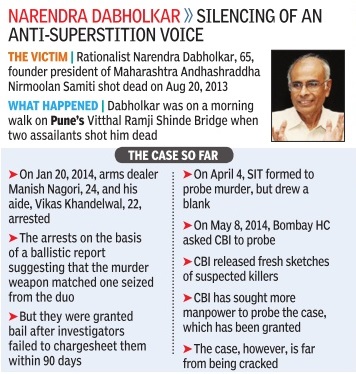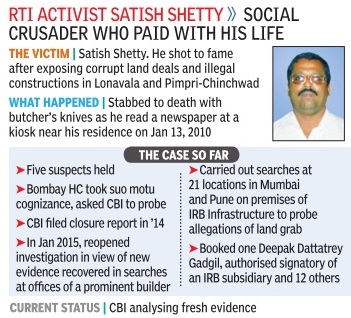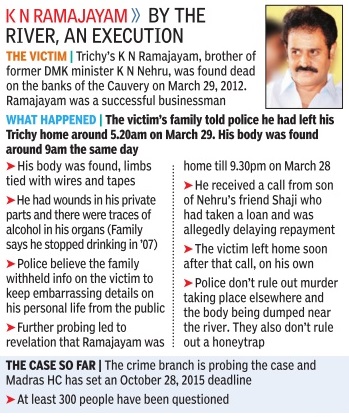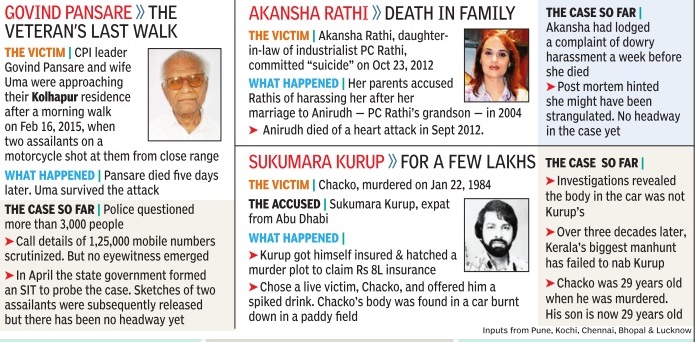Murders: India
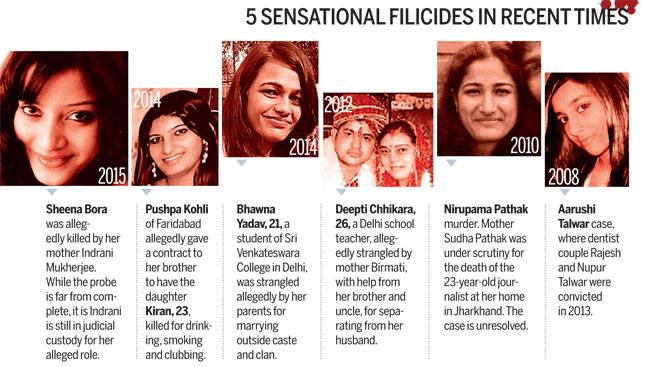
This is a collection of articles archived for the excellence of their content. |
Contents |
Causes
Love, Honour and Land
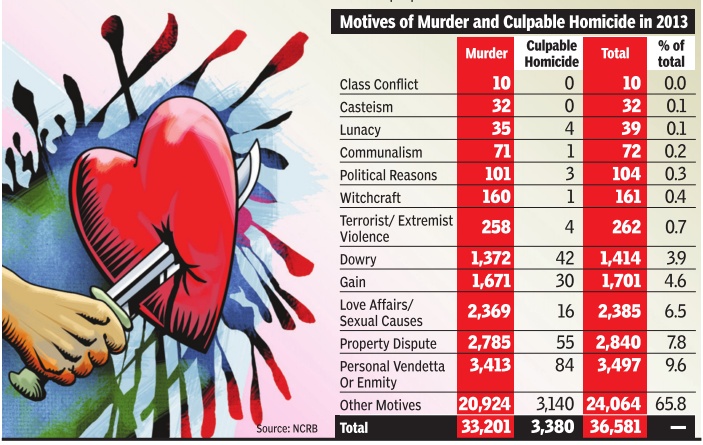
The Times of India Nov 17 2014
Personal vendetta, love affairs and property disputes are the leading causes of murders in India. In 2013, the country witnessed more than 30,000 cases of murder and over 3,000 of culpable homicide not amounting to murder (CH).Investigating agencies identified 12 main motives for these crimes, between them accounting for 35% of all murders and CH. It is surprising to note that even in the 21st century, witchcraft is the reason for over a hundred deaths while communal and caste-related clashes have killed another hundred people
Hasnain Warekar, 35, a chartered accountant from Kasarwadavli, Thane, slit the throats of 14 members of his family, including seven children, in the wee hours of February 27 and then committed suicide. What was wrong with him is still unclear.
In Kolkata this January, Jessica Fonseca and her 16-year-old twin sons were found dead at their house.Her husband Neilconfessed that he had murdered the trio with dumbbells and a knife. The killings were apparently triggered by financial distress.
When police raided the house of Shyam Bahadur Verma, 33, in Surat, on January 24, they found his wife Kirandevi, 30, cut into pieces. Verma had allegedly slit her throat after a quarrel and then cut off her head and limbs. The remains were then chopped into pieces and some bits dropped into a rivulet nearby.
After a stray dog carried a piece of human limb to police officers in Khaderpet in Warangal, Telangana, the bodies of 14-year-old tribal girls Banothu Priyanka and Banothu Bhoomika were recovered. Their bodies were found chopped to pieces in a forest, 25 kms from their native place.
Ashish Kumar, 27, slit his girlfriend’s throat after a stroll at a tea-estate and then clicked a selfie with her. Police say he suspected the girl was having affairs with other men. He uploaded the dead girl’s photo as his display picture on Whatsapp. A headless female body was found in a dustbin in a Chennai suburb. The police discovered it belonged to small-time actress Sasirekha after her husband admitted to killing her and then dumping her severed head in a canal and her torso in a bin.
A merchant navy seaman murdered his wife and her lover. Dhruv Kant Thakur, 29, had a verbal spat with his wife and her lover at her place. In a fit of rage, he killed the man with a knife and then went on to smother his wife with a pillow.
Gurmeet Kaur, a resident of Hoshiarpur, Punjab, admitted to bludgeoning her four-year-old son against the train wall and throwing the body out of the train. She said she had no affection for the child and killed him on her way to Delhi.
A man in Shivamogga city in Karnataka attempted to kill one of his daughters while she was asleep. The reason: she was in love with a taxi-driver from another caste. However, she was not the one who died as the father inadvertently stabbed her younger sister, who was 16 years old.
A gynaecologist at a district hospital in Rampur in eastern UP killed a baby by severing its head while aiding a woman in child delivery. The doctor is said to have used a rope to pull out the baby when its leg first emerged. The infant’s head was then surgically removed and its body discarded in a bin.
Naveen Khatri of north-west Delhi took his girlfriend Arzoo Singh, 23, on a ride out of town, strangled her with a dupatta, brought the body back in his car and stuffed it in a ventilation shaft from where it was recovered four days later.
Judicial pronouncements
'Body of victim not essential to prove murder': Courts
The Times of India, Aug 31 2015
Swati Deshpande
Courts have ruled if there is proof, body of victim not essential to prove murder
For a crime so cruel that has left the nation transfixed in horror, judicial precedents show that absence of a dead body or failure to identify its charred remnants does not prevent prosecution and even conviction, if compelling circumstantial evidence proves a murder had taken place.
Corpus delicti, a Latin term used to describe the body or foundation of a crime and in popular criminal law jargon, “the body of the murder victim, is not an essential requirement to prove a murder, courts have ruled. Leading criminal law counsel, Amit De sai, said, “If there is compelling evidence of murder, absence of dead body can't prevent conviction. He added, “There is the last seen concept and other circumstances, besides direct evidence and admissible confession, that could play a role in gathering up a body of evidence. Another defence lawyer, Aabad Ponda, said, “Corpus delicti is not mandatory to get a conviction, even in its absence murder can be proved on the basis of strong circumstantial evidence. The Supreme Court has in several rulings in cases dating back to the 1950s cited English court judgments to lay down that lack of a dead body would not allow a person accused of murder to escape unpunished.
Justice M Hidayatullah, up holding a murder conviction in 1959 in the then State of Bom bay, had quoted a British ruling that enunciated the legal principle. “At the trial of a person charged with murder, the fact of death is provable by circumstantial evidence, notwithstanding that neither the body nor any trace of it has been found, and that the accused has made no confession of participation in the crime. Before she can be convicted, the fact of death should be proved... beyond reasonable doubt... “Circumstantial evidence in this context means combination of facts creating a network through which there is no escape for the accused, said the SC, “because as a whole they infer only to guilt.“
The SC bench of Justices P Sathasivam and B S Chauhan held in 2011 (Prithipal Singh vs State of Punjab) that “in a murder case, it is not necessary that the dead body should be found and identified, ie, conviction for murder does not depend on corpus delicti being found... It said, “Conviction can be based on uncorroborated testimony of the accomplice and the “court may act on the testimony of a sole eye-witness, if found reliable.
Rate of murder
1957-2015
See graphic:
Murders and culpable homicide per million per year, 1957-2015
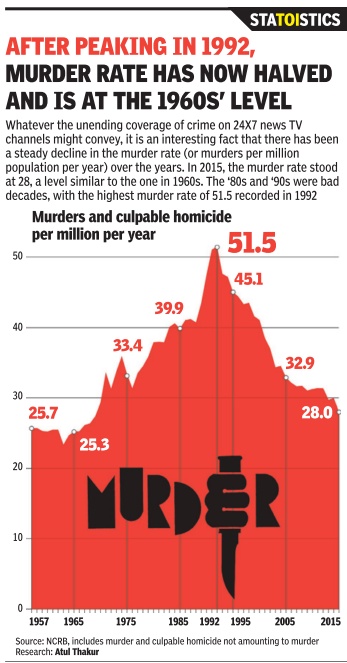
1957-2016
See graphic:
Murders and culpable homicide per million per year, 1957-2016
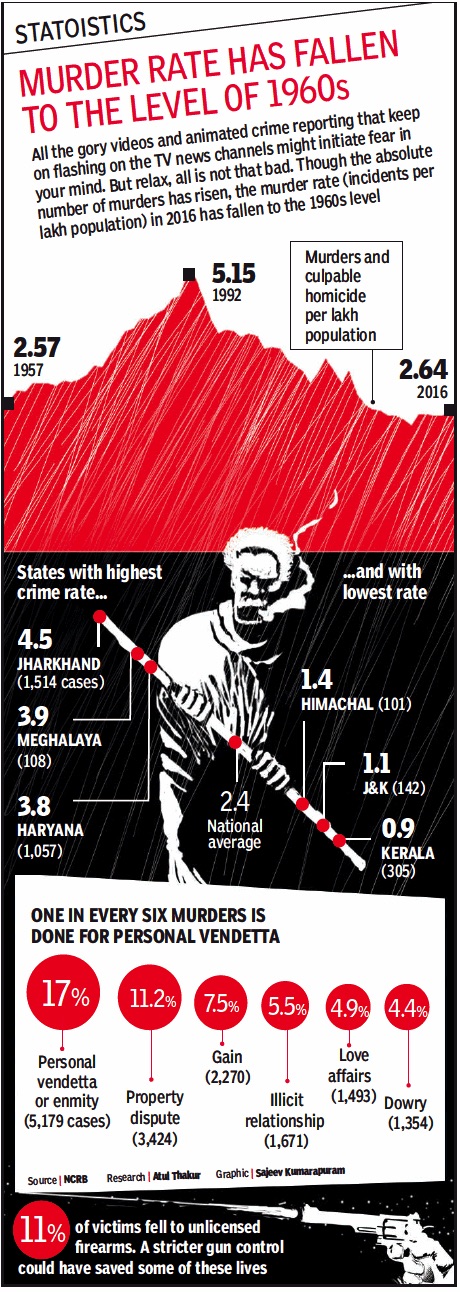
From December 8, 2017: The Times of India
2014: Lowest rate since 1960s
Source:
1. The Times of India, Aug 23 2015
2. The Times of India, Aug 23 2015
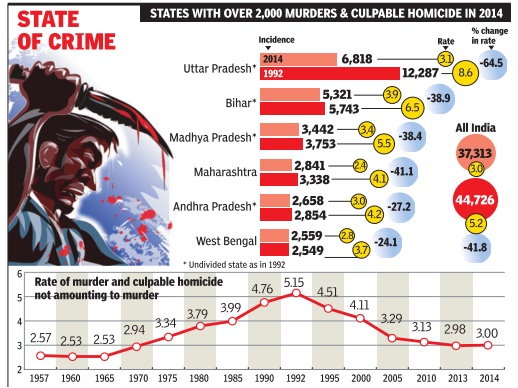
Atul Thakur
Murder count in India falls to its lowest level since 1960s
Fewer murders belie dystopian fears
The murder rate in India in the past few years has been at its lowest level since the 1960s. Even the absolute number of murders in 2014 was lower than in 1992, the year when the murder rate (number of murders per lakh of population) was at its highest.
The counter-intuitive fact emerges from an analysis of data from the National Crime Records Bureau's (NCRB) annual publication, Crime in India. In 2014, the country witnessed 33,981 murders and 3,332 incidents of culpable homicide not amounting to murder.The combined rate of the two crimes per lakh of population was 3.0 in 2014 and 2.98 in the previous year. A lower rate was last recorded in 1970, when 16,180 murders and 2,357 culpable homicides amounted to a combined rate of 2.94.
While NCRB has data on the absolute number of murders from 1952, it has been reporting the rate from 1957. It shows the rate started increasing from the mid-60s to reach its peak in 1992 when the combined rate was 5.15, roughly double the level in 1957. Since 1992, it has been falling rather steadily. The state-wise compari son of the data for 1992, the peak year, and 2014 shows that murder rates (number of murders per lakh of population) have decreased in 26 of the 32 states and UTs that existed at that time. (To make the data comparable, 2014 figures of Andhra Pradesh & Telangana, Bihar & Jharkhand, Uttar Pradesh & Uttarakhand, Madhya Pradesh and Chhattisgarh have been clubbed together).
In 1992, Uttar Pradesh witnessed 12,287 incidents of murder and culpable homicide not amounting to murder. It was followed by Bihar (5,743), Madhya Pradesh (3,753), Maharashtra (3,338) and Andhra (2841). Although the order is the same in 2014, all of these states have seen the absolute number of incidents dropping.Uttar Pradesh and Uttarakhand put together had 6,818 incidents, while for undivided Bihar and Madhya Pradesh, the number of incidents was 5,321 and 3,442 respectively. Similarly Maharashtra and undivided Andhra also saw a decline.
In the past two decades, the population of all states has gone up by several millions and therefore the rate of incidents has dropped significantly , in some cases to less than half their 1992 levels. It is not clear why the murder rate first in creased rapidly and then has dropped equally sharply , but what is clear is that impressionistic ideas of society getting increasingly violent may need to be revisited.
2015: Murders, state-wise
The Times of India, Sep 01 2016
Dipak Kumar Dash & Pervez Iqbal Siddiqui
Uttar Pradesh had 68% share of the total number of honour killings reported in 2015, the latest report of the National Crime Records Bureau (NCRB) says. The abnormal increase in the number of such cases from one in 2014 to 131 in 2015 has stumped many .
The NCRB report released reported a seven-fold rise in honour killing cases in 2015, Uttar Pradesh registering the largest number. Gujarat and Madhya Pradesh followed.
Honour killing as a separate segment was introduced in the NCRB report in 2014.
Similarly, UP registered steep rise in political murders --from two in 2014 to 28 last year. Jharkhand, Kerala and MP came second, third and fourth in political killings in 2015. Last year 96 political killings were registered across the country against 64 the previous year.
On the stunning rise in honour killings, an NCRB source said: “Whenever we notice an abnormal spike in cases, we get them verified with the state crime records bureau before publishing them. This procedure was followed even in the case of Uttar Pradesh.“ Senior state police officers told TOI that the sharp rise in honour killings could be because of better public awareness. Registration of such cases may rise even further because social media use is becoming popular even in the hinterland.
UP DGP Javeed Ahmed said honour killing was a social crime and believed stringent police action could act as a deterrent to some extent. “But, it is about creating awareness that such killings aren't a solution to complex social issues,“ he said. Former Lucknow University vice-chancellor Roop Rekha Verma refused to accept that only one honour killing took place in UP in 2014. Many such crimes were not even reported, believes Verma.
“People have now started reporting such crimes. Earlier these were lumped with just other murders,“ said Madhu Garg, state general secretary of All India Democratic Women's Association.
The NCRB report also showed an increase in murders resulting from love affairs and illicit relationships.
2015: Pakistan worst, Nepal best in S.Asia
See graphic:
The Rate of murder in Bangladesh, India, Nepal, Pakistan, Sri Lanka, and other major countries
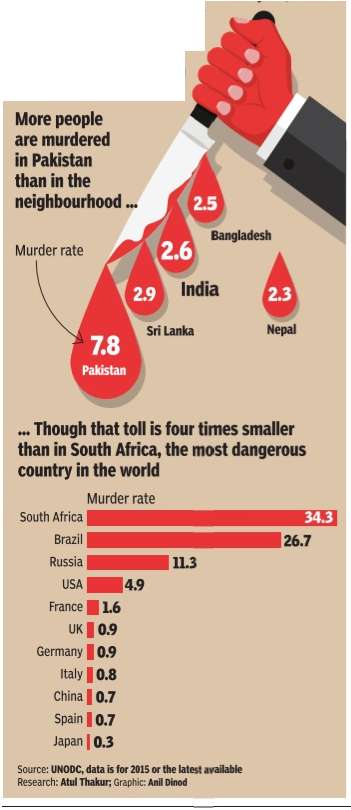
From: October 31, 2017: The Times of India
Road rage murders
2016: 95% of road rage murders took place in UP
Uttar Pradesh’s reputation of being a lawless land suffered another dent with NCRB data pointing to it being home to the most hotheads on the road.
Out of 4,889 murders in the state in 2016, almost 10% (489 murders) were blamed on road rage, shows the annual crime data compiled by National Crime Records Bureau (NCRB).
Interestingly, 513 murders were reported in 29 states and 7 Union Territories in which the motive of murders was registered as ‘road rage’, which means 95% of all such murders were committed in UP.
In all, 30,450 murders were committed across the country in 2016 and UP reported the most cases of homicides. Thirteen road rage murders were reported from Maharashtra, three from Gujarat, two each from Manipur and Chhattisgarh and one each from Karnataka, Kerala, Madhya Pradesh and Delhi.
The NCRB, however, says that this road rage data provided by UP government is under clarification.
Till 2015, road rage incidents were recorded by NCRB under the head rash driving/road rage, linking it to incidents which have happened while driving. It is for the first time NCRB has listed a separate ‘road rage’ head for motive of murders.
According to NCRB’s 2015 annual report, road rage data was used only for number of cases “causing injuries under rash driving/ road rage” in which states like Kerala, Tamil Nadu, Madhya Pradesh, Karnataka and Maharashtra topped the figures. In 2015, overall cases of road rage and rash driving in the country amounted to 4,51,069. However, this year, 3,48,914 cases where people received injuries due to rash driving have been reported delinking it from road rage.
According to NCRB’s 2016 data, murders due to caste conflict have come down in the country from 828 incidents in 2015 to 134 in 2016. There is a slight increase in political murders — from 96 in 2015 to 113 in 2016, while Naxalism claimed 327 lives.
Unsolved murders
2015, High-profile unsolved murders
See graphics:
Narendra Dabholkar murder case
Satish Shetty murder case
Sarla Mishra murder case
K. N. Ramajayam murder case
Govind Pansare, Akanksha Rathi and Sukumara Kurup murder cases
